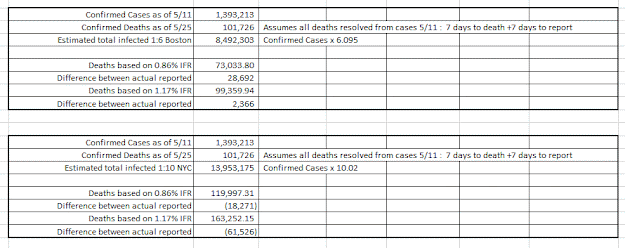Note: Written June 30th
Something changed...
I suspect that the decrease in the CFR is based on more testing, younger people getting infected, and better health outcomes. All of these are good news, but make it difficult to figure out what the Infection Fatality Rate (IFR) is if our leaders really push for herd immunity as our way out.
The IFR can give us an estimate of the number of deaths we could expect if all we do is wait for herd immunity to control the infection.
My best guess as to the number of infected is based on what we found with the Diamond Princess and the Aircraft Carrier Theodore Roosevelt. What we see there, one with old folks and one with healthy young people, should give us an idea on what is happening in the US as a whole.
For the Diamond Princess:
Among 3,711 Diamond Princess passengers and crew, 712 (19.2%) had positive test results for SARS-CoV-2 (Figure 1). Of these, 331 (46.5%) were asymptomatic at the time of testing.
For the USS Theodore Roosevelt:
A new U.S. study of the COVID-19 outbreak aboard USS Theodore Roosevelt (CVN-71) found that one in five sailors infected with the virus were asymptomatic, while the loss of smell and taste were the most common symptoms of the disease.
This asymptomatic number is critical in figuring out who is getting tested and who is not. In both these cases testing was provided to all and was not reliant upon a person going in to be tested.
We do know that because of the shortage and cost of tests, many asymptomatic people who knew they were exposed were discouraged from testing or chose not to partake.
We can assume, therefore, that if for every one symptomatic case on the Diamond Princess there was an asymptomatic infected person, for every one case reported you have twice that many infected.
If you look at the USS Theodore Roosevelt, symptomatic appears to include "loss of smell and taste." I speculate that in the US population those symptoms would not drive many people to get tested. Unfortunately, the research does not break down what percentage of those tested who positive only reported loss of taste & smell or mild symptoms. What they do report is that for every five symptomatic, one was asymptomatic.
Based on the Boston numbers, I am going to assume an IFR of 0.86%. I think that is reasonable in calculating an upper bound number of deaths should herd immunity be the only course of action.
Using the most recent numbers from above, here is what I calculate
What these two tables attempt to show is how close my model (IFR and Ratio of cases to asymptomatic non-reported cases) can get to the numbers reported in WorldoMeters.
There are a lot of assumptions here, but I am looking to get a reasonable estimate so as to calculate what herd immunity might cost us in lives lost to COVID-19.
As time goes on, I think we will - or have - seen less vulnerable people getting infected as well as better health outcomes for those who are symptomatic.
I also think we are testing more and capturing more asymptomatic people which increases the known cases reported.
This assumption seems to be borne out by my calculations as they switch (more known cases both symptomatic/asymptomatic) and an IFR of 0.86%.
What does this all mean?
Well we need to consider an IFR of at least 0.86% ans we need to recognize that the number of reported cases does not equal the number of total infected. More testing is needed to know how many have had COVID so we can know if out health care has improved and what risk of death we can expect.
Need more data!
Down the rabbit hole of death we go. Time to meet the President.
Next Post Part 9



No comments:
Post a Comment